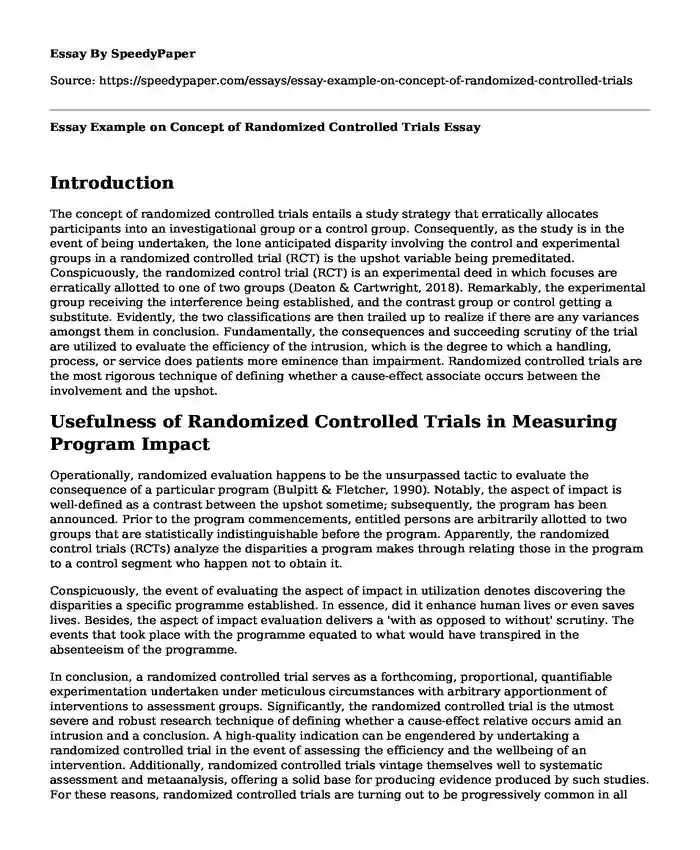Introduction
The concept of randomized controlled trials entails a study strategy that erratically allocates participants into an investigational group or a control group. Consequently, as the study is in the event of being undertaken, the lone anticipated disparity involving the control and experimental groups in a randomized controlled trial (RCT) is the upshot variable being premeditated. Conspicuously, the randomized control trial (RCT) is an experimental deed in which focuses are erratically allotted to one of two groups (Deaton & Cartwright, 2018). Remarkably, the experimental group receiving the interference being established, and the contrast group or control getting a substitute. Evidently, the two classifications are then trailed up to realize if there are any variances amongst them in conclusion. Fundamentally, the consequences and succeeding scrutiny of the trial are utilized to evaluate the efficiency of the intrusion, which is the degree to which a handling, process, or service does patients more eminence than impairment. Randomized controlled trials are the most rigorous technique of defining whether a cause-effect associate occurs between the involvement and the upshot.
Usefulness of Randomized Controlled Trials in Measuring Program Impact
Operationally, randomized evaluation happens to be the unsurpassed tactic to evaluate the consequence of a particular program (Bulpitt & Fletcher, 1990). Notably, the aspect of impact is well-defined as a contrast between the upshot sometime; subsequently, the program has been announced. Prior to the program commencements, entitled persons are arbitrarily allotted to two groups that are statistically indistinguishable before the program. Apparently, the randomized control trials (RCTs) analyze the disparities a program makes through relating those in the program to a control segment who happen not to obtain it.
Conspicuously, the event of evaluating the aspect of impact in utilization denotes discovering the disparities a specific programme established. In essence, did it enhance human lives or even saves lives. Besides, the aspect of impact evaluation delivers a 'with as opposed to without' scrutiny. The events that took place with the programme equated to what would have transpired in the absenteeism of the programme.
In conclusion, a randomized controlled trial serves as a forthcoming, proportional, quantifiable experimentation undertaken under meticulous circumstances with arbitrary apportionment of interventions to assessment groups. Significantly, the randomized controlled trial is the utmost severe and robust research technique of defining whether a cause-effect relative occurs amid an intrusion and a conclusion. A high-quality indication can be engendered by undertaking a randomized controlled trial in the event of assessing the efficiency and the wellbeing of an intervention. Additionally, randomized controlled trials vintage themselves well to systematic assessment and metaanalysis, offering a solid base for producing evidence produced by such studies. For these reasons, randomized controlled trials are turning out to be progressively common in all assorted fields such as those of medicine precisely perinatology.
Two Ways That Bias May Be Introduced During the Implementation of Randomized Controlled Trials
Fundamentally, there are multiple numerous and assorted ways in which bias may be introduced in the period of randomized controlled trials implementation (Eble et al., 2016). Some of these ways entail the following:
- Selection bias- Apparently, this bias happens to be a consequence of systematic disparities involving baseline physiognomies of the groups that are likened. Primarily, the existence of systematic variations involving baseline characteristics refers to the dispersal of extrapolative aspects varying between the classifications being equated.
- Performance bias- Markedly, this bias occurs as an upshot of systematic disparities involving the individuals in the overhaul that is offered, or in exposure to aspects additional than the interferences of interest. Remarkably, these variances take place due to the indulgence of the allotted handling by study partakers and consequently will be less prospective in incognito trials.
References
Bulpitt, C. J., & Fletcher, A. E. (1990). Measuring costs and financial benefits in randomized controlled trials. American heart journal, 119(3), 766-771. Retrieved from https://www.sciencedirect.com/science/article/pii/S0002870305800596
Deaton, A., & Cartwright, N. (2018). Understanding and misunderstanding randomized controlled trials. Social Science & Medicine, 210, 2-21. Retrieved from https://www.sciencedirect.com/science/article/pii/S0277953617307359
Eble, A., Boone, P., & Elbourne, D. (2016). On minimizing the risk of bias in randomized controlled trials in economics. The World Bank. Retrieved from https://elibrary.worldbank.org/doi/abs/10.1596/1813-9450-7746
Cite this page
Essay Example on Concept of Randomized Controlled Trials. (2023, Apr 30). Retrieved from https://speedypaper.com/essays/essay-example-on-concept-of-randomized-controlled-trials
Request Removal
If you are the original author of this essay and no longer wish to have it published on the SpeedyPaper website, please click below to request its removal:
- Free Essay about Treatment Planning
- Terrorism Financing Essay Example
- Essay Sample Describing the Experience of Team's Leadership
- Essay Example Dedicated to Solar Panel Cleaning Robots
- Essay Sample: Economic Impact of Registered Nurses Tardiness on an Institution
- Reflective Essay on Plagiarism
- Essay Example on Juvenile Mass School Shooters
Popular categories





